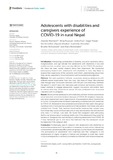| dc.contributor.author | Morrison, Joanna | |
| dc.contributor.author | Poudyal, Niraj | |
| dc.contributor.author | Pun, Insha | |
| dc.contributor.author | Prasai, Sagar | |
| dc.contributor.author | Shrestha, Nir | |
| dc.contributor.author | Khadka, Dipesh | |
| dc.contributor.author | Shrestha, Sushmita | |
| dc.contributor.author | Rohwerder, Brigitte | |
| dc.contributor.author | Wickenden, Mary | |
| dc.coverage.spatial | Nepal | en |
| dc.date.accessioned | 2023-06-20T14:39:49Z | |
| dc.date.available | 2023-06-20T14:39:49Z | |
| dc.date.issued | 2023-06-09 | |
| dc.identifier.citation | Morrison, J.; Poudyal, N.; Pun, I.; Prasai, S.; Shrestha, N.; Khadka, D.; Shrestha, S.; Rohwerder, B. and Wickenden, M. (2023) 'Adolescents with Disabilities and Caregivers Experience of COVID-19 in Rural Nepal', Frontiers in Public Health, DOI: 10.3389/fpubh.2023.1189067 | en |
| dc.identifier.uri | https://opendocs.ids.ac.uk/opendocs/handle/20.500.12413/18026 | |
| dc.description.abstract | COVID-19 caused severe disruption to the lives of adolescents. UNICEF estimates that school closures affected more than 1.6 billion learners, with those in low- and middle-income countries having the least access to remote learning. There is growing concern about the longer term effects of the pandemic on adolescents’ health, well-being, literacy, income and professional opportunities. Adolescence is a time of psychological and social transformation. At puberty, parent–child relationships evolve as adolescents seek more independence and autonomy, and both peers and parents become reference points for adolescents as they learn to deal with more intense emotions. Research shows that peer influences on health and well-being are greater in adolescence than at any other time in the life course. Peer interaction is important to develop cognitive abilities to navigate social networks and understand others’ perspectives. Physical distancing as part of COVID-19 control measures has meant that many adolescents have been socially isolated at this crucial time in their social development. It is likely that the effect of COVID-19 has been amplified for adolescents with disabilities, who are more likely to live in poverty without access to the internet, who are less likely to attend school, and are more likely to experience social exclusion than adolescents without disabilities. Our qualitative research explores and reflects on the experience of adolescents with disabilities in rural Nepal and adds to the literature in developing an inclusive understanding of the effect of the COVID-19 pandemic on adolescents with disabilities. | en |
| dc.language.iso | en | en |
| dc.publisher | Frontiers | en |
| dc.rights.uri | http://creativecommons.org/licenses/by/4.0/ | en |
| dc.subject | Children and Youth | en |
| dc.subject | Health | en |
| dc.title | Adolescents with Disabilities and Caregivers Experience of COVID-19 in Rural Nepal | en |
| dc.type | Article | en |
| dc.rights.holder | © 2023 Morrison, Poudyal, Pun, Prasai, Shrestha, Khadka, Shrestha, Rohwerder and Wickenden | en |
| dc.identifier.externaluri | https://www.frontiersin.org/articles/10.3389/fpubh.2023.1189067/full | en |
| dc.identifier.doi | 10.3389/fpubh.2023.1189067 | |
| rioxxterms.funder | Default funder | en |
| rioxxterms.version | VoR | en |
| rioxxterms.versionofrecord | 10.3389/fpubh.2023.1189067 | en |


